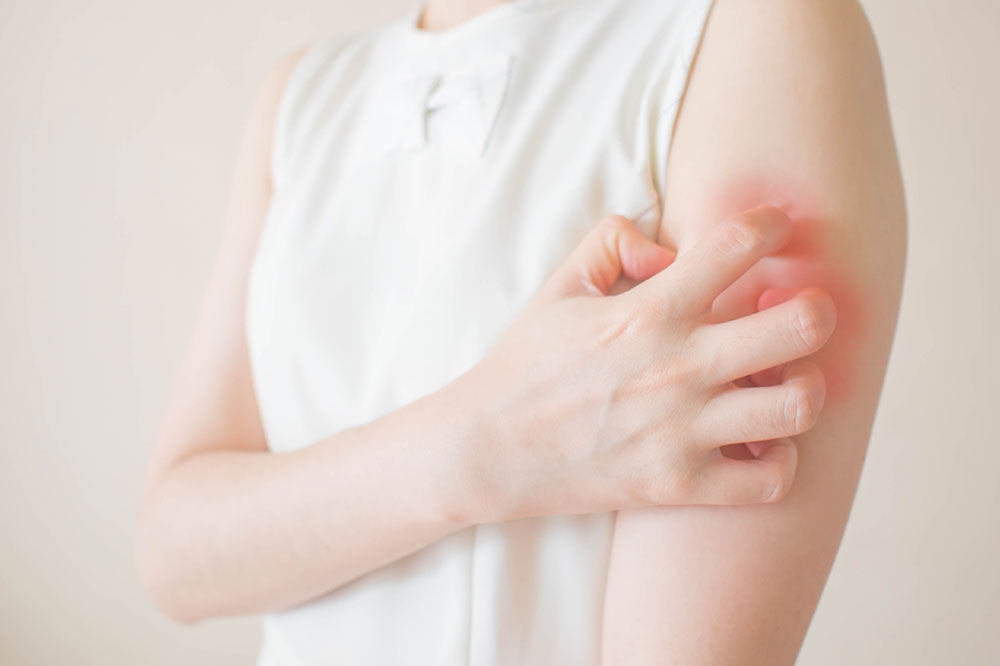
Types of skin rashes – Their symptoms and management
A skin rash is a condition in which the skin changes color and texture abnormally. This may happen due to some inflammation or trigger response from the body’s immune system. There are several types of rashes that can be identified depending on their signs and symptoms. The treatment for these varies based on the type. Let’s talk about the signs and symptoms of different skin rashes and ways to manage them.
Eczema
This is a common skin condition and is also commonly known as atopic dermatitis or atopic eczema. It can affect both children and adults. The causes for this condition include a family history of allergies; however, a definite cause has not been found yet. Some triggers can lead to skin inflammation and irritation, so be sure to look out for the symptoms.
- Symptoms of eczema
Some of the common signs and symptoms of this condition are itchiness, skin redness, scaly, dry, or crusted skin, which is a result of consistent scratching and itching, small blisters filled with fluid or pus that may break while scratching, and infection caused due to the torn and irritated skin.
Granuloma annulare
This is a chronic skin condition characterized by circular-shaped rashes. This kind of rash usually affects young adults and children and is usually more common in girls and those who are otherwise healthy.
- Symptoms of granuloma annulare
The cause of this condition is unknown, but here are some signs and symptoms of the disease. The skin condition can typically be identified by the firm, ring-shaped bumps formed on the skin. This is usually found around the forearms, hands, or feet. Unlike eczema, this rash is not as itchy and is mostly mild.
The doctor may ask for a skin biopsy, a standard diagnostic procedure, to confirm the condition.
Lichen planus
In this skin disorder, shiny and flat-topped bumps develop on the patient’s skin. This kind of condition mostly affects adults aged between 30 and 70.
- Symptoms of lichen planus
Here are some signs and symptoms of this condition. Shiny, flat-topped bumps appear on the insides of the wrists, ankles, neck, lower legs, and back. Sometimes these bumps also appear inside the mouth, nails, scalp, and genital region. Shins is another area where these bumps may be noticed. They are noticed to be angular in shape and have a reddish-purplish color.
The condition is triggered when one’s immune system mistakenly attacks skin or mucous membranes cells. It is an autoimmune disease; however, the exact reason of what causes it. Some research shows that hepatitis B can be a triggering agent, while some also suggest hepatitis C to be a common trigger. This is known as the lichenoid reaction.
Pityriasis rosea
This is a mild skin rash condition. While the cause of the disease is yet to be understood, research shows that a virus could cause it because the rash looks similar to an illness caused by a viral infection. However, the rash is not contagious and does not spread from one person to another.
- Symptoms of pityriasis rosea
Here are some of the signs and symptoms that point toward pityriasis rosea. The rash begins with a large, pink, scaly patch, which can appear on the chest or back. More patches of pink skin may appear. These patches are inflamed, appear red, and can be itchy. The number and sizes of the spots may vary. Apart from the back and chest, this kind of rash can also be noticed on the abdomen, upper arms, and legs.
Diagnosis
Usually, the doctor may simply see and identify the skin rash without any tests; however, tests are conclusive and may eradicate any other possible infections in many cases. The tests differ for different conditions; the doctors may do blood tests, get a scrape of your skin, do a skin biopsy and send samples to a lab.
Prevention and management
Treatment, prevention, and management of a skin rash also depend on the type of condition. Eczema requires the person to moisturize often. They are recommended to avoid visiting places with extreme weather changes and wear comfortable and loose clothes. Excess sweating may cause scratching, consequently triggering inflammation. Some conditions demand ultraviolet light therapy. In the case of granuloma annulare, the doctor may even ask to freeze the lesion with liquid nitrogen.
There are some lifestyle changes and food plans that may help manage symptoms; however, it is always advisable to speak to a doctor and nutritionist to get a proper plan. Ensuring that there is no allergic reaction to any home remedies or food ingredients is important to avoid any flare-ups.




